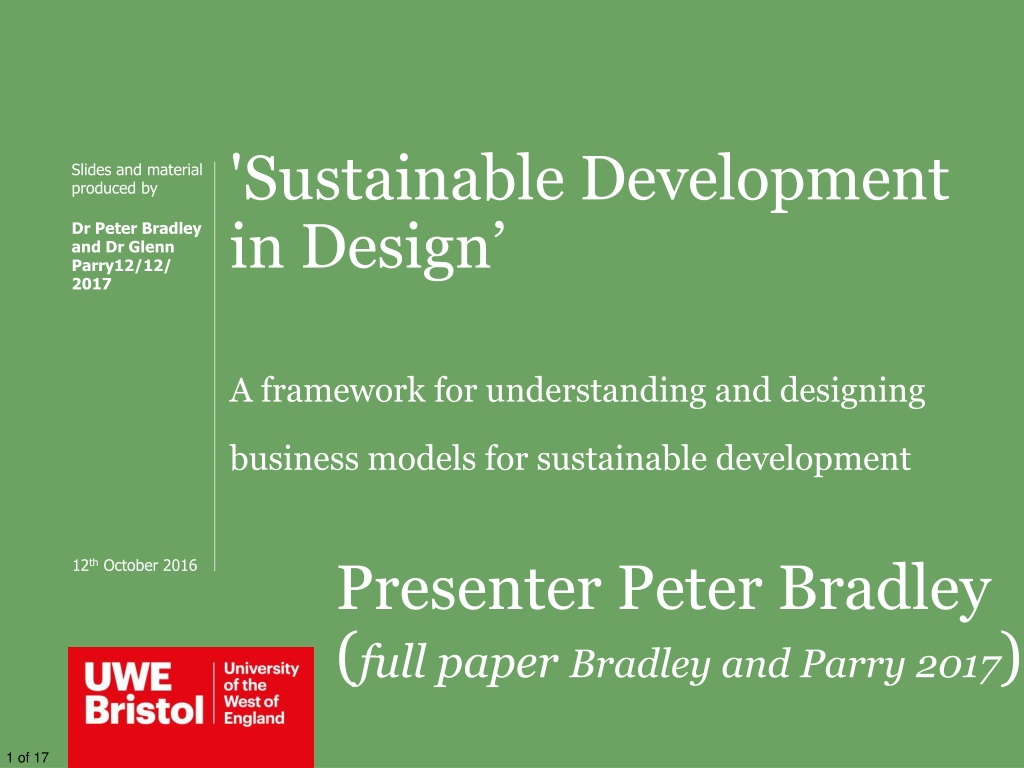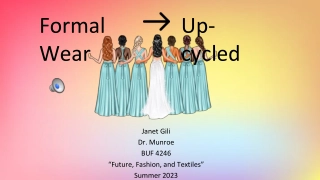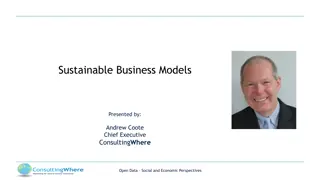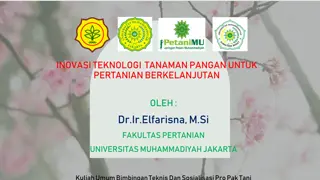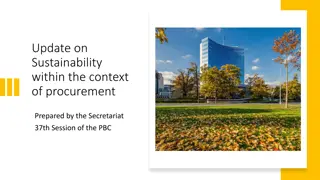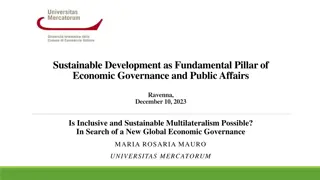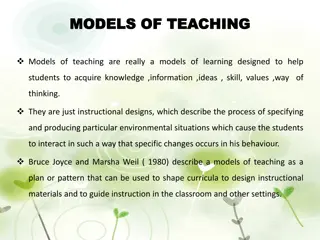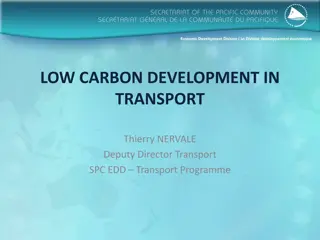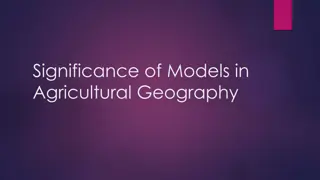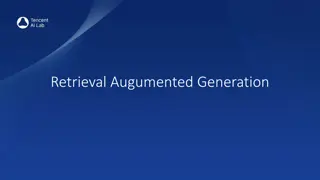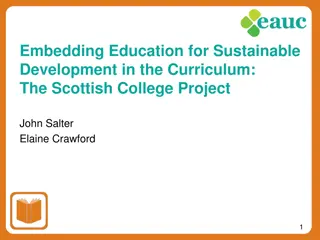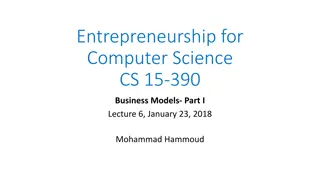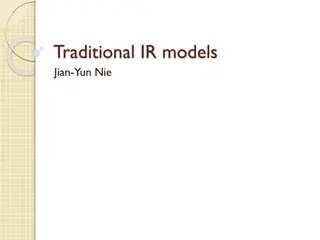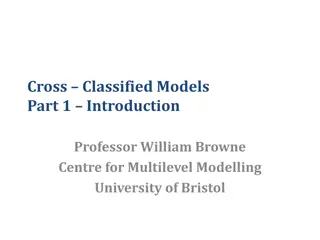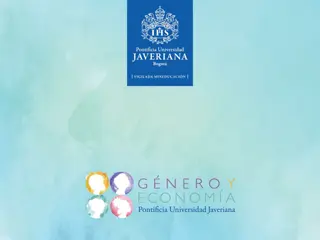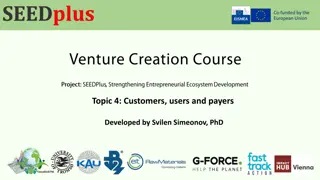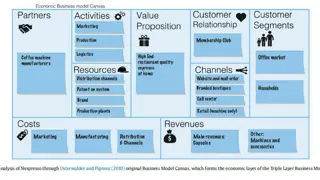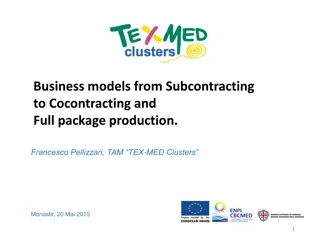A Framework for Sustainable Business Models
This content dives into sustainable development concepts, business models, value creation, and perception of value. It discusses how businesses deliver value to customers while ensuring profitability and sustainability. Explore different perspectives on value and its importance in the business context.
Download Presentation

Please find below an Image/Link to download the presentation.
The content on the website is provided AS IS for your information and personal use only. It may not be sold, licensed, or shared on other websites without obtaining consent from the author. Download presentation by click this link. If you encounter any issues during the download, it is possible that the publisher has removed the file from their server.
E N D
Presentation Transcript
'Sustainable Development in Design Slides and material produced by Dr Peter Bradley and Dr Glenn Parry12/12/ 2017 A framework for understanding and designing business models for sustainable development Presenter Peter Bradley (full paper Bradley and Parry 2017) 12thOctober 2016 1 of 17
Overview Sustainable development Business models Value The torch light framework ; Results from application 2 of 17
Sustainable development development that meets the need of the present without compromising the ability of future generations to meet their own needs Three main aims: improved equity in resource distribution across and within societies; improving human well-being; development that stays within environmental constraints and maintains ecological integrity over intergenerational timescales (Our Common Future, 1987, Sneddon et al, 2006) 3 of 17
What are business models? A business model describes how value is delivered to customers and society, how customers in turn are willing to pay for the 'value' received, thus resulting in profit and sustainability for the provider architecture of the value creation, delivery and capture mechanisms it employs (Teece, 2010); Business model definitions focus on value, usually equated to profit Source: Parry, G. and P. Tasker (2014). Value and servitization; creating complex deployed responsive services? , Strategic Change, 23, pp. 303-315 4 of 17
What is value? Conceptually we take it to be some measure of goodness Source: Ng, I. C. L. (2014), Creating new markets in the digital economy: Value & Worth, Cambridge University Press: Cambridge 5 of 17
How do we think about value? Plato (360 B.C.E) proposed things are either intrinsically or extrinsically valuable o good to have for themselves o let you obtain something else that is good o the two aren t mutually exclusive Moore (1903) rejects this and states things are only good if they are perceived to be good! Value is based upon individuals perception 6 of 17
Plato, Aristotle and this chap present value as utility existing in the exchange of unitary outputs In The Wealth of Nations 1776 Adam Smith characterised wealth creation though export of goods Value is usually seen as in exchange o it is often thought markets create value This continues to underpin contemporary business thought [1723-1790] 7 of 17
Which is most valuable? 100kg Gold 12 sheets of Polystyrene Pack Of 4 Insulation Polystyrene Sheet 2400mmx1200mmx50mm 8 of 17
Value is a measure of how good something is when situated in use and in context A boat has use value at sea; plastic has use value on land (as a carrier bag) when in the ocean it generate dis-value for society and the environment 9 of 17
Torch-Light model applied Key resources Cost Structure Expertise; financial capital; physical assets, buildings, cable, technology and demonstration technology; management resources; renewables and gas 80% is the people - intellectual and engineering capability. Technology and infrastructure is 20%. Variable cost is mainly buying gas to support energy generation. Key stakeholders and partners Borough council; energy customers; Total gas; UK government (through Combined heat and power policy); The grid and wider population; the council electorate C V C L C S K R K S & P K A C R C C S Channels, value chain & linkages Vertically integrated - generate, sell product (electricity and heat), meter, distribute and take payment/debt recovery, all value delivered by the firm (boutique); Communication distribution via website and other means, industrial information fora, demonstration projects and programs; Supply chain used for some material inputs to production such as gas, specialised contractors sometimes used. Key activities Generation of electricity, heating and cooling; distribution, metering, billing systems; maintenance; governance and administration; dissemination of information (overtly and by stealth); 10 of 17 6 of 17
Torch-Light model applied Customer segments Commercial and domestic energy customer; The Borough council; Organisations and Industry; C V C L C S K R K S & P K A C R C C S Value proposition affordable, low carbon energy delivery, to meet local and national government energy policy at minimum cost, which attracts certain businesses to site themselves in the local area and through these activities, enhancing the reputation of the local council owners locally and globally Customer relationships & sensing Energy customers are paying; The Borough council are paying; Organisations and Industry sometimes Pay for consultancy; National governments do not pay; Local community beyond energy users do not pay. 11 of 17 6 of 17
Torch-Light model applied Cost Structure Key resources Key stakeholders and partners C V C L C S Customer segments K R K S & P K A Channels, value chain & linkages C R C Value proposition C S Key activities Wider societal value Customer relationships & sensing Lens Value captured: Funding by the council for cost effective policy delivery and subsequent reputation enhancement; Domestic and commercial energy provision; Demand response services; Consultancy services; Revenue to council from businesses joining the low carbon network. Value captured by company 12 of 17
Problems, context and value Problems Problem: Energy Energy provision/independence at low cost (individual and societal use value) Low CO2 energy CO2policy implementation at low cost (societal use value) Political (being elected) Value to the local council (individual value use value) Economic development Economic value to local area (societal exchange and use value) Context: Combined heat and power and demand side response rules Local energy and CO2policy Democracy Desirability of carbon energy networks to some types of businesses (resulting in inward investment) & council aims on economic development 13 13 of 17
Summary A number of standard business models frameworks are available such as Osterwalder and Pigneur business model canvas tend to focus on exchange value; The torch light Torch Light framework builds on past work addressing gaps in relation to conceptions of value, integration of context and sustainability. A good business model should act to facilitate the strategy discussions in your business For more help - Peter.Bradley@uwe.ac.uk or Glenn.Parry@uwe.ac.uk 14 of 17
Peter Bradley Senior Lecturer, UWE Leader in Sustainable Development PhD in Sustainable Development, University of Surrey Current Research: Principal investigator of Understanding and assessing business models for sustainability. Past Research: EPSRC funded fellowship on the industrial and social ecology of urban resource flows; Research fellow on an EPSRC funded project at the University of Surrey: Reshaping Energy Demand of Users by Communication Technology and Economic Incentives (REDUCE); Researcher with the Research Group on Lifestyles Values and Environment (RESOLVE). Latest publications: Webber, D., Webber, G., Berger, S. and Bradley, P. (2017) Explaining productivity in a poor productivity region. Environment and Planning A. ISSN 0308-518X [In Press] Available from: http://eprints.uwe.ac.uk/33085 Bradley, P., Fudge, S. and Leach, M. (2016) Motivating energy conservation in organisations: Smart metering and the emergence and diffusion of social norms. Technology Analysis & Strategic Management, 28 (4). pp. 435-461. ISSN 0953-7325 Available from: http://eprints.uwe.ac.uk/27692 Bradley, P. (2016) Environmental impacts of food retail: A framework method and case application. Journal of Cleaner Production, 113. pp. 153-166. ISSN 0959-6526 Available from: http://eprints.uwe.ac.uk/27877 15 of 17
Ends Questions? 16 of 17
